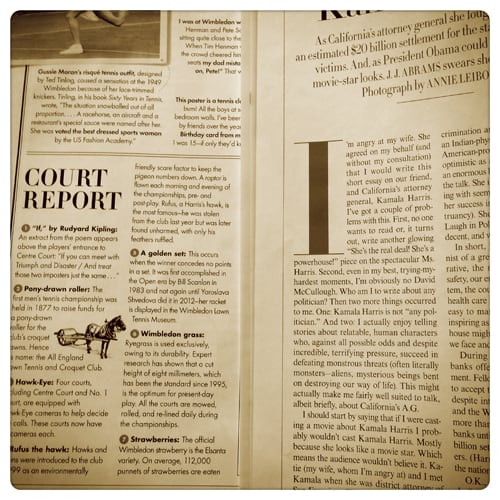
When was last time you read a company’s marketing blurb (be it a website, brochure or whatever) word for word?
It’s rare to read marketing materials word for word – unless you’re really interested in what they’re saying, right?
Your own prospects and customers are no different.
Skim-reading is a way of life in the fast-paced, high-tech world we live in.
Therefore, for your marketing to be effective, you need to acknowledge that and make it easy for people to skim-read your marketing.
(This is especially true online, where attention spans are particularly short and your competitors’ websites are just a mouse click away.)
What are the benefits of encouraging people to skim-read?
Encouraging your prospects to skim-read is a good idea.
Why? By letting their eyes glance at the information in a way that they can absorb it quickly means that your prospect is more likely to retain the knowledge and information.
In turn, this means that you’re more likely to make the sale!
Not convinced?
If you’re not convinced that letting people skim read will help your sales, imagine the opposite scenario. In this instance, imagine big huge chunks of dense text.
Yep, we’re talking solid walls of words… no paragraphs, no sub-headings, just a big, never-ending mass of words. (Think: like a school essay or some kind of scientific report.)
Unless you’re an academic, the big chunks of text are visually very daunting. You subconsciously think, “yikes, that looks intense and boring” when you see a solid mass of words.
Example: two articles from the same magazine…
In the photo below are two articles from the same magazine.

The article on the left has sub-headings, bold, bullet points… whilst the article on the right is a solid mass of words, with no “breathing space” around them.
Which would you rather read (if they were both on the same topic)?
I know which I’d prefer to read… and your prospects are no different. They’d rather read information that’s broken down into digestible, consumable chunks than be confronted by intimidating blocks of information.
Here’s how you can make your marketing materials nice and digestible for your readers…
7 tips on how to make your marketing materials easy to skim read
1. Use headlines
An enticing heading is the important first step in making sure that your marketing piece gets read.
After all, if your piece doesn’t grab the reader’s attention, your effort is wasted!
Here are some articles to help you:
Here’s an easy-peasy headline-writing technique you can use right away…
2. Use sub-headings
Meaningful sub-headings help to break down the information on the page, and let the eye navigate the information.
Notice how this article uses this technique to break down the information into easy, navigable chunks. You can quickly pick up the main messages of this article, even if you don’t read every single word.
Make sure you employ the same technique in your own writing!
The trick is to make the sub-headings meaningful (i.e. longer than just one word), and to put them in bold so they stand out. Sometimes it’s nice to use a larger font size than for your body copy, too.
Bonus tip: Use colours for your headings and sub-headings: this helps them to stand out. Pure black-and-white copy can look very flat and dull. Choose a colour and use it consistently (it should be a colour that matches your corporate colour scheme).
3. Keep sentences and paragraphs short
Marketing and sales copy should be snappy and punchy – and that means using short sentences.
Using long sentences confuses readers… and why make it difficult for people to read your materials?
Short sentences are easy to read, and easy to understand. And “easy to read and easy to understand” are highly-desirable characteristics of sales and marketing copy!
Notice too how I’ve used short paragraphs in this article. In fact, most paragraphs are one to five sentences long.
There are two reasons why short paragraphs are a good idea:
(a) The white space between the paragraphs gives the copy some “breathing space”. This is attractive to people visually, so they are more likely to read your content. So it helps with attracting attention and getting read.
(b) The “breathing space” allows readers to digest the information you’re telling them. The gaps between the paragraphs are like little mini-breaks for the brain, that allow new information to sink in, bit by bit. So this helps with readers absorbing what you have to say, and taking action.
The golden rule is to have just one idea per paragraph. (Yes, even if that means just one sentence per paragraph, that’s absolutely fine! Remember, you’re writing marketing and sales copy, not a school essay!)
4. Emphasise important things in bold
Headings and sub-headings should be in bold, but other important words could be in bold too, so that they really stand out.
A word of warning though: don’t be tempted to over-use this technique, or your marketing piece will look cluttered. Use this sparingly!
5. Use bullet points for lists
Do you have a whole list of things to say?
Then put them in a bulleted list!
Again, this breaks down the information nicely. It’s simply a lot easier to read a bulleted list than a long, rambling line of information.
Bonus tip: Put the most important words at the beginning of the sentence. This will help the reader pick up the important information even if they don’t read the whole sentence. Why? People tend to scan vertically down the left hand side as they read. So if the important words are all on the left, the words will get noticed.
Extra bonus tip: When you’re using bullet points and putting the most important words at the beginning of the sentence, consider making those important words bold. This will help them to stand out even more and your copy will be super-skim-readable!
6. Use photos and graphics – and write captions for them
A picture really does paint a thousand words.
Good graphics help to get attention – and they also help to lock your message into readers’ minds.
How to choose eye-catching photographs for your marketing
Don’t just use a photograph without putting it into context – otherwise it could raise more questions than it answers. Instead, be sure to write a meaningful caption with every photograph that you use.
Here are some articles I’ve written to help you with caption writing:
How one measly sentence could double your readership
How to write photo captions that’ll get remembered
Understanding features and benefits and how to use them in photo captions
7. Two common formatting mistakes to avoid
You have more formatting tools at your disposal than I’ve mentioned here, but there are a couple of things you should avoid:
(i) Avoid underlining
Underlining words for emphasis looks amateurish. Pick up any book, and I bet there will be no underlining. Professional typesetters and publishing companies simply don’t use underlining.
The only time when it’s OK (and preferable) to underline is online, for hyperlinks. This is a good idea for usability because it lets readers know that the text is a hyperlink.
(Conversely, it’s super-annoying online when people underline copy that isn’t a hyperlink!)
(ii) Avoid excessive italics
To demonstrate this point, I am purposely writing a whole paragraph in italics. Perhaps you’re tilting your head to the side a little bit to read it… maybe even squinting your eyes a little… am I right? In other words, large chunks of text in italics are difficult to read – and even more so online than in print. I have no idea why that is, but computer screens and italics do not go well together! This applies to email marketing (newsletters, autoresponders and sales emails) as well as to website copy.
You may use italics selectively for emphasis, for perhaps a word or a sentence… but no more than that, please!
I often see people putting testimonials on their website in italics, and this is incredibly hard to read. You are better off using your normal type style, and putting the testimonial-giver’s name in italics.
Why make it hard for prospects to read your testimonials?! (Or any of your other copy!)
Summary
- It’s more enticing to read copy with “breathing space” than words that are crammed tightly together.
- If your copy lets prospects easily skim read it, it is therefore more likely to get read.
- The “breathing space” also lets readers’ brains absorb the information, so your message is more likely to stick.
- Here are 7 ways in which you can make your copy easier for people to skim read:
- Use headlines
- Use sub-headings
- Keep sentences and paragraphs short
- Emphasise important things in bold
- Use bullet points for lists
- Use photos and graphics – and write captions for them
- Avoid making the common mistakes of underlining for emphasis (except for hyperlinks) and excessive italics (just a word or sentence for emphasis is enough).
Do you need help with your copywriting projects?
Cornelia Luethi (founder of The Leaky Bathtub) specialises in writing website copy, email autoresponders and articles for English-speaking clients the world over.
Visit Words By Cornelia for full details on these copywriting services.




